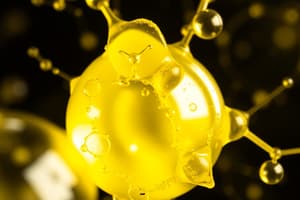Podcast
Questions and Answers
What is the significance of the periodic table in predicting the behavior of elements during a redox reaction?
What is the significance of the periodic table in predicting the behavior of elements during a redox reaction?
The periodic table helps predict how elements will react based on their electronegativity and oxidation states.
Can you describe the difference between oxidation and reduction in a redox reaction?
Can you describe the difference between oxidation and reduction in a redox reaction?
Oxidation is the loss of electrons, while reduction is the gain of electrons.
Which elements commonly act as oxidizing agents, and why?
Which elements commonly act as oxidizing agents, and why?
Elements with high electronegativity, such as fluorine and chlorine, commonly act as oxidizing agents due to their ability to gain electrons easily.
Explain the importance of balancing redox reactions.
Explain the importance of balancing redox reactions.
What steps are commonly followed to balance a half-reaction in a redox process?
What steps are commonly followed to balance a half-reaction in a redox process?
Flashcards are hidden until you start studying
Study Notes
The Periodic Table and Redox Reactions
- The periodic table organizes elements based on their electron configurations and chemical properties.
- Elements within the same group (column) have similar chemical properties.
- This similarity is due to similar arrangements of valence electrons, which are involved in chemical reactions.
- The periodic table helps predict how elements will react in redox reactions, specifically how readily they will gain or lose electrons.
Oxidation and Reduction
- Oxidation: The loss of electrons by an atom, ion, or molecule.
- Reduction: The gain of electrons by an atom, ion, or molecule.
- Redox Reactions: Reactions where oxidation and reduction occur simultaneously.
- Oxidizing Agent: A substance that causes oxidation by accepting electrons.
- Reducing Agent: A substance that causes reduction by donating electrons.
Common Oxidizing Agents
- Nonmetals: Tend to be good oxidizing agents due to their high electronegativity, meaning they have a strong tendency to attract electrons.
- Examples: Oxygen (O2), halogens (F2, Cl2, Br2, I2), and sulfur (S)
Balancing Redox Reactions
- Essential for accurately describing the stoichiometry (relative amounts of reactants and products) of a redox reaction.
- Ensures that the number of atoms and charges are equal on both sides of the chemical equation.
- This guarantees the conservation of mass and charge, fundamental principles in chemistry.
Balancing Half-Reactions
- Redox reactions are often divided into two half-reactions: one for oxidation and one for reduction.
- Steps for balancing half-reactions:
- Balance the atoms of the element being oxidized or reduced.
- Balance the oxygen atoms by adding water (H2O) molecules.
- Balance the hydrogen atoms by adding hydrogen ions (H+) to the appropriate side.
- Balance the charges by adding electrons (e-) to the side with a more positive charge.
Studying That Suits You
Use AI to generate personalized quizzes and flashcards to suit your learning preferences.




